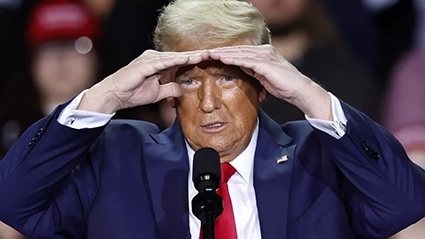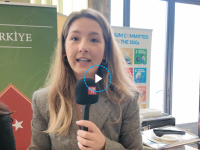Politic. Trump budget proposes unprecedented, ‘reckless’ cuts to foreign aid

The budget request would make massive cuts to global health, humanitarian aid, and core economic and development work.
The Trump administration’s proposed budget for fiscal year 2026 would make unprecedented cuts to foreign aid, which some called “reckless” and “self-defeating.”
The White House released its budget request on Friday that proposes a 47.7% cut in funding for state and international programs from 2025 levels, down to $31.2 billion, and signaling its intention to rescind about $20 billion in funds previously approved by Congress. If successful, the total would amount to a roughly 84% cut to the foreign affairs budget, leaving just $9.6 billion in new spending.
“Overwhelming cuts to effective assistance would be reckless and self-defeating, threatening lives and stability around the world,” said Elizabeth Hoffman, executive director for North America at the ONE. “Erasing hard-earned partnerships and progress in the name of saving a fraction of a percent of the US budget would be the true waste.”
It’s unclear what the U.S. could even do if the funding level is $9.6 billion, said Lisa Bos, InterAction’s vice president for global development policy, advocacy, and learning. “At the end of the day, this is really cutting off your nose to spite your face.”
If enacted, nearly every piece of the United States’ development and humanitarian assistance will be hit — with the deepest cuts slated for United Nations funding, economic assistance, development aid, humanitarian support, and global health programs. United Nations funding, for example, would drop by 87%, while humanitarian funding would be halved, according to an analysis from the U.S. Global Leadership Coalition.
Several accounts would be effectively eliminated and consolidated into a new America First Opportunity Fund, a bucket of money meant to focus on “strategic investments that make America safer, stronger and more prosperous.”
“The proposed cuts to America’s International Affairs Budget (adjusting for inflation) would bring investments to the lowest level since World War II,” said Liz Schrayer, the president and CEO of the U.S. Global Leadership Coalition, in a statement Friday. “Turning inward was a mistake then and it’s a mistake now.”
Winners of this proposal appear to be the U.S. International Development Finance Corporation, which will get nearly $3 billion more in funding, and the World Bank’s International Development Association, which is slated to receive $3.2 billion over three years. Although that’s $800 million less than former President Joe Biden committed to IDA in December of 2024, some worried the U.S. might not have contributed at all.
It’s worth noting that the president’s budget request is genuinely a guide, but Congress can ultimately decide how to fund the U.S. government. In President Donald Trump’s first term, he recommended significant foreign aid cuts — not as steep as in this budget request — but Congress pushed back and kept funding relatively even with previous years. But this is a different Congress, and thus far, it has shown much less willingness to restrain the administration’s slashing of foreign aid.
“It will be telling to see how this lands on [Capitol Hill],” said Erin Collinson, director of policy outreach at the Center for Global Development. “We’ll see if there’s any sort of forceful pushback, or at least some acknowledgement that this is up to appropriators in the end.”
There are still a lot of unknowns. The “skinny” budget released on Friday offers limited detail. There’s no mention of agencies such as the Peace Corps and the Millennium Challenge Corporation, nor of the Global Fund to Fight AIDS, Tuberculosis and Malaria, or Gavi, the Vaccine Alliance.
“I think the administration is putting forward a budget that doesn’t reflect the reality of where Congress is — and hopefully Congress, as it considers the proposal, puts their stamp on it and says what they’re comfortable with and what they’re not,” said Bos.
The adds
The budget creates a new $2.9 billion America First Opportunity Fund — referred to as the A1OF Fund — to “focus on strategic investments that make America safer, stronger, and more prosperous.” It would support partners, including India and Jordan, counter China, and fund new activities to support national security priorities.
In an earlier leaked memo obtained by Devex, one program flagged for funding through the A1OF is the South Pacific Tuna Treaty, which grants U.S. fishing rights in the economic zones of other countries.
“This really takes away the congressional power of the purse in a way that I hope the Hill isn’t willing to do,” explained Bos. “If there’s funding that could go along with the whims of any administration every four years, the ability to really do programming effectively is hindered.”
“One administration’s priority may not be the priority of the next administration — and then there’s just a seesaw, back and forth,” she added.
DFC is slated to receive $2.8 billion more in 2026, much of which will go to a new $3 billion revolving fund that would allow DFC to keep and reinvest returns from its investments. Some other bilateral development finance institutions are structured this way, allowing them to retain and reinvest earnings.
DFC’s budget increase is intended to help the institution “support U.S. national security and American interests” through its investments, which would then generate returns for taxpayers and “reduce reliance on foreign aid.” Development is not mentioned, though the budget later indicates that it is strengthening DFC “to shift America’s global posture from handouts to investments,” that return a profit to taxpayers and make America safer, stronger, and more prosperous.
Another (relative) winner is the International Development Association, or IDA, the World Bank’s fund for the poorest countries. The administration intends to provide $3.2 billion to IDA over the next three years — and though that is well below the $4 billion pledged by the Biden administration in December, it will likely be well received by those worried the U.S. might not contribute at all. A World Bank spokesperson told Devex they “don’t generally comment this early in the legislative process.”
Other funding to multilateral development banks did not fare as well, however, with some $555 million in cuts expected, including to the African Development Bank’s African Development Fund, which supports the poorest countries and is seeking a replenishment this year.
Trump’s hopeful foreign aid changes for FY2026, based on the president’s discretionary budget request.
The cuts
$8.3 billion: Economic and development support
The largest cuts target four categories: development assistance, the Economic Support Fund, the Democracy Fund, and assistance for Europe, Eurasia, and Central Asia.
Last year, the U.S. government channeled $3.93 billion into development assistance, and another $3.89 billion into the Economic Support Fund — a bucket of money that for decades has provided flexible aid for countries struggling with political, economic, or security challenges, according to a breakdown from the U.S. Global Leadership Coalition.
While support for the Democracy Fund, and Europe, Eurasia, and Central Asia were relatively smaller — $345 million and $770 million, respectively — the carveouts represent a major blow for the world’s development assistance. And the reasoning? U.S. economic and development aid, the budget request states, has been “funneled to radical, leftist priorities.”
If the president’s budget were passed as is, funding for these four accounts would be eliminated, while any duplicative accounts would be combined into the America First Opportunity Fund — and used at the president’s discretion. It’s worth noting that Trump tried a similar move in his first term, but Congress rejected the idea of doing away with the Economic Support Fund and the Development Account.
“It’s a really odd and interesting approach to say, Congress will allocate some buckets of funding that are fully in the hands of the administration,” said Bos. “Is how that funding is going to be used going to be transparent? Will that be posted online? Will Congress need to approve it? It’s not clear, but they seem to be pretty unaccountable pieces of the foreign aid budget.”
$6.2 billion: Global health
Some of the largest cuts in the foreign aid budget are directed toward global health, a sector that many thought would be relatively protected by the sweeping cuts. Year over year, the U.S. has been the world’s largest donor to global health programs, providing $12.3 billion in funding in 2024. But in the latest budget request, Trump is hoping to halve that, stating that such funding supports abortions abroad — despite the fact that in 1973, the Helms Amendment made doing so illegal.
The budget seems to preserve funding for those currently served by the country’s flagship HIV program, the President’s Emergency Plan for AIDS Relief. But while the document states that support for PEPFAR’s “current beneficiaries” would continue, Bos explained that the plan would exclude those getting infected with HIV every day — and there’s no mention of whether the support would include prevention and testing, or just antiretroviral drugs.
“I think the administration is trying to pull out little things that they are willing to support, and that’s not how these programs work,” said Bos. “This idea that you can pull out little pieces of the program … makes everything else completely ineffective.”
$3.2 billion: Humanitarian aid
The budget will slash $3.2 billion in humanitarian aid, shuffling money across the International Disaster Assistance account, the Emergency Refugee and Migration Assistance account, and the newly created International Humanitarian Assistance bucket — with the latter being slated for cuts before its structure has even been set in stone.
In 2024, the U.S. government spent $8.7 billion on humanitarian assistance. Just over half of that came through the International Disaster Assistance Fund, while another $3.9 billion was channeled through the Migration and Refugee Assistance bucket, and some $100,000 went through the Emergency Refugee and Migration Assistance account, according to the U.S. Global Leadership Coalition.
Under the new proposal, total humanitarian spending would drop to just $3.5 billion — 40% of what the U.S. government allocated last year. Disaster assistance is labeled “unaffordable,” and the budget request states that the president would be allotted $1.5 billion through the Emergency Refugee and Migration Assistance account to use “at his discretion,” while “wasteful and duplicative accounts” would be consolidated into a $2.5 billion International Humanitarian Assistance, or IHA, account “to fund disaster relief when it fulfills the President’s foreign policy aims.”
There are other cuts in development and humanitarian assistance, too: the Transition Initiatives account, which provides fast, flexible funding for countries undergoing political transitions, is eliminated in the request, along with the Complex Crisis Fund — one of two pots of money that supports the Global Fragility Act, a piece of legislation Trump signed into law in December of 2019.
$1.7 billion: United Nations
—
The U.N. is also on the chopping block, with the budget pushing for a $1.7 billion cut to the world’s largest multilateral system. Before Trump returned to the White House, the U.S. funded more than a quarter of the U.N.’s budget — and now, it seems like all contributions toward the institution will be paused unless Trump chooses to support the U.N. through the America First Opportunity Fund.
On top of that, all funding for U.N. peacekeeping missions — about $1.6 billion — is slated for elimination, with the budget stating “recent failures and high level of assessments” made such programs “wasteful.” The U.S. has historically paid more than its fair share of such operations, the document continued, while accusing U.N. peacekeepers of trafficking narcotics, gold, and diamonds.
$1.6 billion: Food aid
Food for Peace — the country’s flagship hunger initiative — is slated to be eliminated entirely. For years, the program has held strong bipartisan support, largely due to the fact that it buys surplus goods from American farmers across Republican-controlled states.
Despite its influential backers, Food for Peace has long faced criticism: by sourcing goods from the U.S. rather than local producers, and requiring that those goods be shipped on U.S. flagged vessels, Food for Peace often results in high commodity and shipping costs than if the food were to be purchased by farmers in the global south. Still, Food for Peace was typically seen as a must-have because it allowed for a stable, constant food supply during times of crisis — and because of the hefty support it garnered from farm lobbies, voters, and the lawmakers representing them.
Trump’s new budget, however, states there are “far more efficient food aid programs” than Food for Peace, and that the budget preserves many of them. Despite that, the only clear international food initiatives listed in the budget — such as the McGovern-Dole Food for Education Program — are criticized for having “high costs with dubious results,” and are slated for elimination too.
Given the historically bipartisan support for Food for Peace, the program’s termination could face backlash in Congress.
$315 million: Democracy
The president’s budget request proposes slashing $315 million from the National Endowment for Democracy — a nonprofit funded by Congress that promotes democracy, advances human rights, and strengthens civil society worldwide.
For the last four decades, the NED has worked with its four key institutions — the National Democratic Institute, the International Republican Institute, the Solidarity Center, and the Center for International Private Enterprise — to do just that. But earlier this year, NED became a target, with billionaire and Trump ally Elon Musk taking to social media to blast its work.
“NED is a RIFE with CORRUPTION!!” Musk posted on X, the social media platform that he owns, later calling it an “evil organization that needs to be dissolved.”
In the budget request, the Trump administration accused NED of funding a Ukrainian “disinformation organization that doxed U.S. journalists called for prosecutions of allies of the President, and attacked the Vice President … as ‘foreign propagandists of the Russian Federation,’” among other claims that could not be independently verified by Devex.
Bits and pieces
Sixteen smaller agencies are also targeted for elimination, including the Inter-American Foundation, the U.S. African Development Foundation, the U.S. Institute of Peace, and the U.S. Agency for Global Media, among many other specialized institutions. It’s another nail in the coffin for these agencies, which have been battered by executive orders, court battles, and visits by the Department of Government Efficiency in recent months — many of which have resulted in the mass cancellations of programs and sweeping terminations of staff.
There are also steep cuts to the U.S. Centers for Disease Control, National Institute of Health, the African Development Bank, the African Development Fund, and other pots of money — all of which have global aid implications.
“I think the Hill is open to rethinking the budget, rethinking foreign assistance programs, where the money is best spent and where it can have the most impact,” said Bos. “But this budget request doesn’t do that, and it doesn’t look at this in a very thoughtful way.”
Update, May 5, 2025: This article has been updated to clarify that the Trump administration proposed cutting the food aid budget by $1.6 billion.
By Adva Saldinger, Elissa Miolene // 03 May 2025










